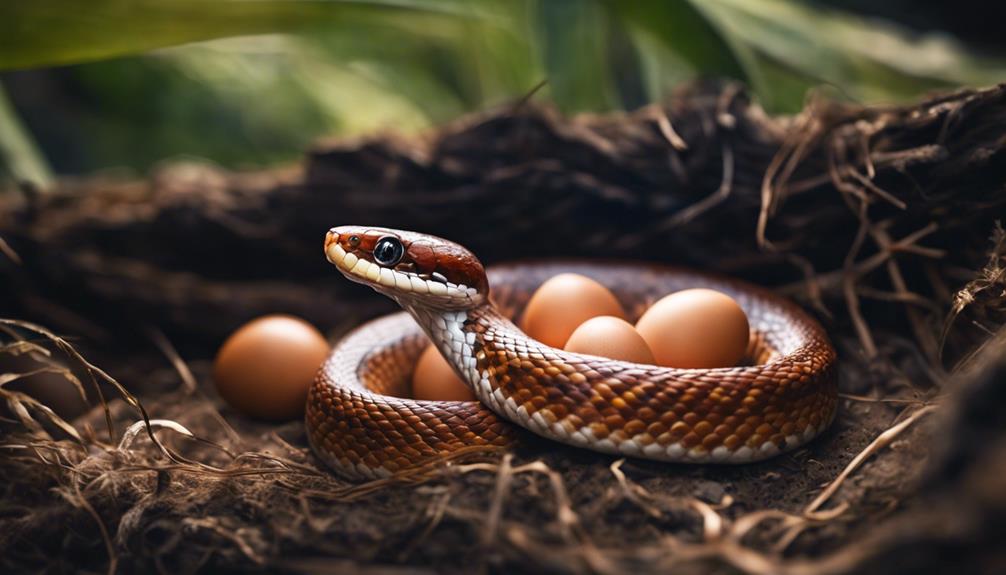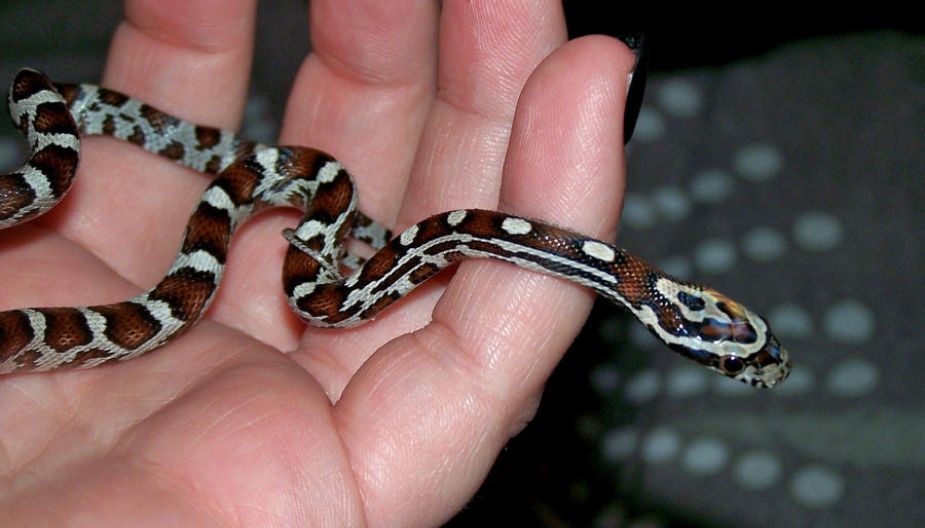Have you ever pondered over whether female corn snakes can lay eggs without a male?
The answer may astonish you. Although it’s not typical, it can occur through an intriguing process called parthenogenesis.
This rare reproductive phenomenon prompts fascinating queries about the genetic diversity of the progeny.
Keep reading to delve into the step-by-step process of how female corn snakes can independently produce new life.
Yes, female corn snakes can lay eggs without a male; this is known as parthenogenesis. However, while they can lay eggs, the resulting offspring may not always be viable.
Female Corn Snakes Reproductive Anatomy
In female corn snakes, the reproductive anatomy includes two functional ovaries where eggs develop and mature, along with oviducts responsible for transporting eggs to the cloaca. The ovaries are where the process of follicular development begins, leading to the formation of eggs. Once the eggs are mature, they’re released from the ovaries and travel through the oviducts toward the cloaca, which serves as the common opening for reproduction and waste elimination in corn snakes.
The oviducts play a pivotal role in the reproductive process of female corn snakes by providing a pathway for the eggs to be transported. These specialized tubes make sure that the eggs are moved efficiently from the ovaries to the cloaca for eventual laying. During the breeding season, the oviducts are especially active as they facilitate the passage of eggs, either for fertilization if there’s been mating or for potential storage if fertilization is delayed. Understanding the intricate workings of the female corn snake’s reproductive anatomy sheds light on the fascinating process of egg development and laying.
Ovulation and Egg Development Process
Exploring the ovulation and egg development process in female corn snakes reveals intricate mechanisms governing reproductive strategies in these fascinating reptiles. Female corn snakes can ovulate without mating, a phenomenon vital for their reproductive success.
- Ovulation Triggers: Factors like age, weight, and environmental conditions can stimulate ovulation in female corn snakes. These triggers play a significant role in initiating the reproductive cycle.
- Egg Production: During ovulation, female corn snakes produce eggs that can be fertilized through mating with a male or develop through parthenogenesis, a process where unfertilized eggs develop into embryos without male genetic contribution.
- Parthenogenesis: Parthenogenesis in corn snakes is a remarkable reproductive strategy where females can produce offspring without mating. Understanding this process sheds light on the adaptability and resilience of these snakes in various environments.
Nesting and Egg-Laying Behavior
Upon completing the ovulation and egg development process in female corn snakes, their nesting and egg-laying behavior becomes a critical aspect of their reproductive cycle. Female corn snakes exhibit specific behaviors signaling the onset of egg-laying. One such behavior is the pre-lay shed, where the snake sheds its skin in preparation for laying eggs. This shed is a vital indicator for snake owners to provide a suitable nest box.
Creating a nest box is essential to mimic the natural environment where corn snakes would lay eggs in the wild. The nest box should be secure and humid to maintain ideal conditions for egg-laying. Female corn snakes will seek out a secluded and safe location to lay their eggs, emphasizing the importance of providing a suitable nest box within their enclosure. Understanding and catering to the nesting behavior of female corn snakes is crucial for successful egg-laying and subsequent care of the eggs.
Incubation Period and Care
The successful incubation of corn snake eggs hinges on maintaining precise temperature and humidity levels throughout the process. Here are three important aspects to take into account during the incubation period:
- Incubation Period: Corn snake eggs typically require an incubation period of around 60-75 days. This duration is critical for the embryos to develop fully before hatching.
- Temperature Control: Keeping a stable temperature between 27-29°C within the incubator is essential for the proper development of the eggs. Fluctuations in temperature can negatively impact the embryos, so consistent monitoring is key.
- Humidity Levels: Maintaining proper humidity levels of around 70-80% in the incubator is crucial for successful hatching. The right humidity helps prevent the eggs from drying out and aids in the healthy growth of the embryos.
Hatching and Offspring Care
For successful hatching and care of offspring from female corn snakes, precise temperature control and monitoring of humidity levels are important factors to take into account. When preparing for the hatching process, make sure to have an egg box ready with suitable substrate for the eggs. Here is a table outlining key points for hatching and caring for offspring from parthenogenesis:
| Aspect | Description |
|---|---|
| Temperature | Maintain stable temperatures between 27-29°C for successful egg incubation. |
| Humidity Levels | Proper monitoring of humidity levels is essential for healthy offspring. |
| Egg Box Preparation | Make sure the egg box is prepared with appropriate substrate for the eggs. |
| Double Clutching Behavior | Be aware that female corn snakes may exhibit multiple clutches of eggs. |
Frequently Asked Questions
Do Female Corn Snakes Lay Eggs Without a Male?
Yes, female corn snakes can lay eggs without a male through parthenogenesis, a process where unfertilized eggs develop into offspring. This unique snake reproduction mechanism results in genetic half-clones of the mother, impacting breeding and genetic diversity.
How Can a Snake Lay Eggs Without a Male?
You wonder how a snake can lay eggs without a male. Asexual reproduction, known as parthenogenesis, enables female cornsnakes to reproduce without mating. This process, triggered by factors like sperm retention, produces genetic half-clones, impacting genetic diversity.
What Do Unfertilized Snake Eggs Look Like?
Unfertilized snake eggs appear white, leathery, and lack visible veins. They show no signs of embryo development. Their texture is softer than fertile eggs, smaller, and may look wrinkled or irregular. This indicates reproductive biology and genetics.
Can Snakes Lay Eggs on Their Own?
Sure, snakes can reproduce asexually through a process called parthenogenesis. This means they can lay eggs on their own without mating. Offspring produced this way are genetic half-clones of the mother, showcasing the wonders of nature’s adaptation.
Conclusion
To summarize, female corn snakes are capable of laying eggs without a male through the fascinating process of parthenogenesis. This rare occurrence results in half-clones of the mother due to terminal fusion automixis.
It’s important to provide proper care during the incubation period, ensuring stable humidity and temperature.
By understanding the unique reproductive abilities of female corn snakes, we gain insight into the remarkable diversity and adaptability of nature.


